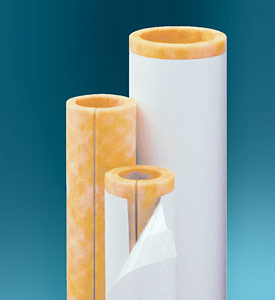TTL thinking in action: A case study of installing steam pipe insulation
 Saturday, November 6, 2010 at 9:36PM
Saturday, November 6, 2010 at 9:36PM (Here's a different type of post, one that I hope shows the Think, Try, Learn mindset in action. As an experiment, it is like my Cut-Throat post last year. While the project I describe seems mundane, the application of the ideas helped me enjoy it rather a lot. I'm still working on expressing how these connect to the TTL view of the world, so please bear with me.)
I spent half a day putting pipe insulation on our old house's steam pipes in the basement to reduce waste heat. The pipes are without insulation because we had the original asbestos insulation removed earlier this summer for health reasons. The pipes looked something like this before the removal:

The new insulation comes as shaped fiberglass tubes that are split so they can easily be installed on a pipe via a hinging "clamshell" action. It looks like this:

These are installed one piece at a time by:
- Measuring a "run" of steam pipe (there are many elbows and fittings that interrupt up the pipes),
- picking out the right diameter of insulation from the supply (we have three diameters in the basement),
- measuring and cutting a piece to fit, then
- installing that section of insulation on the pipe (hinge it in half, put it around the pipe, close it, then tape the seam).
I'd been putting this job off for a while and took the opportunity of my family being out of town this weekend to do the task. I found a lot of places where TTL thinking helped me get into it, and made the process actually fun. Following are examples of how that happened. Many of them were a result of self-reflection while working, which is itself a result of close observation and analysis - the scientist's perspective, in other words. The main thing that helped was telling myself before I got started that this was an experiment. I've never done it before, I was likely to make mistakes, and lots of learning was definitely going to take place.
- I enjoyed getting more accurate and faster at scoring the insulation for cutting, and then cutting it.
- I managed frustration at one point when I cut the wrong diameter insulation, but then reminded myself that the problem was not irreversible - I knew that I could use the piece later. (I suffer from perfectionism, so little things like this seem overly large to me.) This is an example of treating things as experimental prototypes.
- At one point I had to work behind an electrical panel that blocks access to the pipe behind it. After some frustrating trial and error (it's a very tight space to work in) I decided to take it on as a challenge, and show it who was boss! I had to compromise by leaving a few small sections uninsulated, but I enjoyed the feeling of success with this section. This is an example of the boldness that comes from the confidence of trying lots of things. (For me, any boldness is good boldness!)
- I enjoyed the feeling of mastering the tiny operations that made up the project - cutting, wrapping, and taping - and was able to use my observation skills to pretty much stay in the moment with them. A scientifically-inspired example of chop wood carry water, I suppose.
- I was pleased when an idea popped up for improving the product, in this case to print length markings right on the white wrap. This would eliminate the time-consuming marking-off task. Instead of having to hold the insulation section up to a yardstick, you could simply cut right at the exact point without measuring.
- I enjoyed playing with shortcuts through trial and error. For example, there are places where two steam pipe sections are connected by a fitting of slightly larger diameter than the pipes themselves. I tried "fudging" this by running the insulation right across the connector, instead of cutting it into two sections that did not overlap it. Result: The insulation didn't compress enough, and so there was a gap in the seam. Lesson learned!
- I was less intense about mistakes. Again, they were usually reversible, say when I cut too short or long, or used the wrong diameter. For this project, mistakes are easily forgiven.
- I got a strong feeling of delight when I found a piece I'd already cut that fit exactly in a place I needed it to fit. Surprise!
- I really enjoyed the long runs of steam pipe that allowed my placing entire 3' lengths of insulation without cutting. My record so far is three sections (9'). I tried to mix these up with the more tedious sections needing customized cutting, just so I wouldn't have all the "good" together.
- I really enjoyed the delicious moment at about the two hour point when I realized that the basement had started cooling down (it was pretty steamy before). It was satisfying to get relatively quick results.
- I took pride in doing quality work - making tightly-fitted sections, clean cuts, right angles, seamless taping, etc.
Finally, I loved the gradual process of coming up with a system and routine that made the project go smoothly - figuring out how to mark off the measurement, how to cut cleanly and quickly (and safely!), etc. It was a good project for that because the skills could be aquired quickly, but the scope was not too large.
Overall I might summarize by saying this kind of thinking helped me really savor the process of trying something new and figuring it out.
What do you think?

Reader Comments (3)